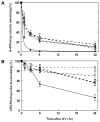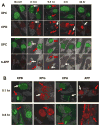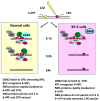Nucleotide excision repair proteins rapidly accumulate but fail to persist in human XP-E (DDB2 mutant) cells
- PMID: 21388382
- PMCID: PMC3082610
- DOI: 10.1111/j.1751-1097.2011.00909.x
Nucleotide excision repair proteins rapidly accumulate but fail to persist in human XP-E (DDB2 mutant) cells
Abstract
The xeroderma pigmentosum (XP-E) DNA damage binding protein (DDB2) is involved in early recognition of global genome DNA damage during DNA nucleotide excision repair (NER). We found that skin fibroblasts from four newly reported XP-E patients with numerous skin cancers and DDB2 mutations had slow repair of 6-4 photoproducts (6-4PP) and markedly reduced repair of cyclobutane pyrimidine dimers (CPD). NER proteins (XPC, XPB, XPG, XPA and XPF) colocalized to CPD and 6-4PP positive regions immediately (<0.1 h) after localized UV irradiation in cells from the XP-E patients and normal controls. While these proteins persist in normal cells, surprisingly, within 0.5 h these repair proteins were no longer detectable at the sites of DNA damage in XP-E cells. Our results indicate that DDB2 is not required for the rapid recruitment of NER proteins to sites of UV photoproducts or for partial repair of 6-4PP but is essential for normal persistence of these proteins for CPD photoproduct removal.
© 2011 The Authors. Photochemistry and Photobiology © 2011 The American Society of Photobiology.
Figures



Similar articles
-
Influence of XPB helicase on recruitment and redistribution of nucleotide excision repair proteins at sites of UV-induced DNA damage.DNA Repair (Amst). 2007 Sep 1;6(9):1359-70. doi: 10.1016/j.dnarep.2007.03.025. Epub 2007 May 16. DNA Repair (Amst). 2007. PMID: 17509950 Free PMC article.
-
Persistence of repair proteins at unrepaired DNA damage distinguishes diseases with ERCC2 (XPD) mutations: cancer-prone xeroderma pigmentosum vs. non-cancer-prone trichothiodystrophy.Hum Mutat. 2008 Oct;29(10):1194-208. doi: 10.1002/humu.20768. Hum Mutat. 2008. PMID: 18470933 Free PMC article.
-
The UV-damaged DNA binding protein mediates efficient targeting of the nucleotide excision repair complex to UV-induced photo lesions.DNA Repair (Amst). 2005 May 2;4(5):571-82. doi: 10.1016/j.dnarep.2005.01.001. DNA Repair (Amst). 2005. PMID: 15811629
-
Transcriptional and Posttranslational Regulation of Nucleotide Excision Repair: The Guardian of the Genome against Ultraviolet Radiation.Int J Mol Sci. 2016 Nov 4;17(11):1840. doi: 10.3390/ijms17111840. Int J Mol Sci. 2016. PMID: 27827925 Free PMC article. Review.
-
Common pathways for ultraviolet skin carcinogenesis in the repair and replication defective groups of xeroderma pigmentosum.J Dermatol Sci. 2000 May;23(1):1-11. doi: 10.1016/s0923-1811(99)00088-2. J Dermatol Sci. 2000. PMID: 10699759 Review.
Cited by
-
TGF-β signaling links E-cadherin loss to suppression of nucleotide excision repair.Oncogene. 2016 Jun 23;35(25):3293-302. doi: 10.1038/onc.2015.390. Epub 2015 Oct 19. Oncogene. 2016. PMID: 26477308 Free PMC article.
-
Orchestral maneuvers at the damaged sites in nucleotide excision repair.Cell Mol Life Sci. 2015 Jun;72(11):2177-86. doi: 10.1007/s00018-015-1859-5. Epub 2015 Feb 15. Cell Mol Life Sci. 2015. PMID: 25681868 Free PMC article. Review.
-
Genomic mutation landscape of skin cancers from DNA repair-deficient xeroderma pigmentosum patients.Nat Commun. 2023 May 4;14(1):2561. doi: 10.1038/s41467-023-38311-0. Nat Commun. 2023. PMID: 37142601 Free PMC article.
-
Co-infection of HSV-1 amplicons containing the XPC gene and a human artificial chromosome vector into primary XPC deficient fibroblast cells.Biochem Biophys Rep. 2024 Nov 21;40:101875. doi: 10.1016/j.bbrep.2024.101875. eCollection 2024 Dec. Biochem Biophys Rep. 2024. PMID: 39639961 Free PMC article.
-
Poly(ADP-ribose) polymerase 1 escorts XPC to UV-induced DNA lesions during nucleotide excision repair.Proc Natl Acad Sci U S A. 2017 Aug 15;114(33):E6847-E6856. doi: 10.1073/pnas.1706981114. Epub 2017 Jul 31. Proc Natl Acad Sci U S A. 2017. PMID: 28760956 Free PMC article.
References
-
- Bradford PT, Goldstein AM, Tamura D, Khan SG, Ueda T, Boyle J, Oh KS, Imoto K, Inui H, Moriwaki SI, Emmert S, Pike KM, Raziuddin A, Plona TM, DiGiovanna JJ, Tucker MA, Kraemer KH. Cancer and neurologic degeneration in xeroderma pigmentosum: long term follow-up characterises the role of DNA repair. J Med Genet. 2010 doi: 10.1136/jmg.2010.083022. jmg.2010.083022 [pii] - DOI - PMC - PubMed
-
- De Weerd-Kastelein EA, Keijzer W, Bootsma D. A third complementation group in xeroderma pigmentosum. Mutat Res. 1974;22:87–91. - PubMed
-
- Inui H, Oh KS, Nadem C, Ueda T, Khan SG, Metin A, Gozukara E, Emmert S, Slor H, Busch DB, Baker CC, DiGiovanna JJ, Tamura D, Seitz CS, Gratchev A, Wu WH, Chung KY, Chung HJ, Azizi E, Woodgate R, Schneider TD, Kraemer KH. Xeroderma pigmentosum-variant patients from America, Europe, and Asia. J Invest Dermatol. 2008;128:2055–2068. - PMC - PubMed
-
- Kraemer KH, De Weerd-Kastelein EA, Robbins JH, Keijzer W, Barrett SF, Petinga RA, Bootsma D. Five complementation groups in xeroderma pigmentosum. Mutat Res. 1975;33:327–340. - PubMed
-
- Sugasawa K. Regulation of damage recognition in mammalian global genomic nucleotide excision repair. Mutat Res. 2010;685:29–37. - PubMed
Publication types
MeSH terms
Substances
Grants and funding
LinkOut - more resources
Full Text Sources
Molecular Biology Databases

